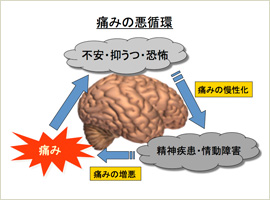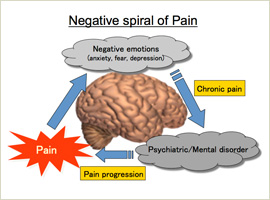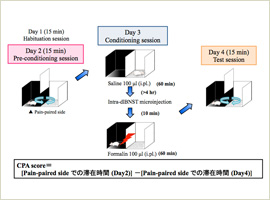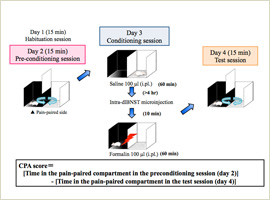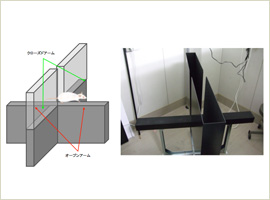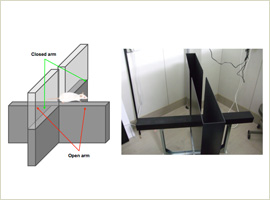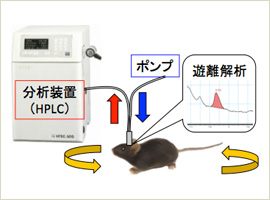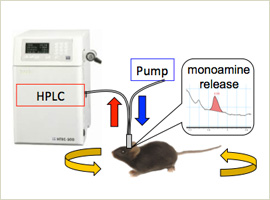快・不快情動の神経機構Neural mechanism of positive and negative emotions
快・不快の情動は行動の動機付けに根本的な役割を果たしていますが、様々な制約により快・不快の情動だけでは行動を決めることはできず、それらが精神的なストレスとなります。近年、私たちを取り巻く社会環境はますますストレスに満ち、それが引き金となって様々な精神疾患・情動障害につながる例も少なくありません。私たちは、動物行動の動機付けの基本となる快・不快情動の神経機構を分子レベルで明らかにするとともに、種々のストレスや薬物が、その神経機構にどのように作用するかを解明することを目指して研究を進めています。私たちの研究が、将来、「こころ」の病を治療する薬の創製に結びつくことを期待しています。
Positive and negative emotions play a fundamental role in motivating behaviors. However, because of various restrictions, we cannot simply act according to positive and negative emotions, which may lead to psychological stress. Social environments are becoming increasingly stressful these days, and they often trigger various mental and affective disorders. Our study aims to demonstrate the neural mechanism of positive and negative emotions on the molecular level, which are fundamental motivators in animal behavior. We also aim to demonstrate how various types of stress and drugs affect the neural mechanism. We hope that the outcome of our study will one day evolve into the development of a therapeutic drug for treating mental illness.
1.痛みによる不快情動生成機構と拡張扁桃体The mechanism of developing pain-induced negative emotions and extended amygdala
痛みによる「好ましくない不快な情動」は、生体警告系としての痛みの生理的役割にとって非常に重要です。しかしながら、痛みにより引き起こされる不安、抑うつ、嫌悪などの不快情動は、患者のQOLを著しく低下させるだけでなく、精神疾患・情動障害の引き金ともなり、また、そのような精神状態が痛みをさらに悪化させるという悪循環をも生じさせます(右図)。このため、痛みの感覚的側面だけでなく情動的側面をも考慮した疼痛治療の必要性が示唆されます。
現在、様々な痛みやストレス負荷動物モデル、種々の行動薬理学的試験法と電気生理学的解析手法を組み合わせて、不安、抑うつ、嫌悪などの不快情動生成メカニズムの研究を行っています。
“Unpleasant and negative emotions” induced by pain play a very important physiological role in the bio-warning system. However, anxiety, depression, aversion, and other negative affections caused by pain significantly decrease the patient’s quality of life (QOL) and trigger mental and affective disorders. Such mental states intensify the pain, resulting in a vicious cycle (See figure on right). Therefore, it is necessary to take both sensory and affective components into account in pain management.
The focus of our study is a region in the brain called the extended amygdala, which is comprised of the bed nucleus of the stria terminalis (BNST), the central nucleus of the amygdala, and the substantia innominata. The extended amygdala is known to have a significant role in the development of negative emotions. We have reported that noradrenaline and corticotropine-releasing factor (CRF) within the ventral and dorsolateral parts of the BNST, respectively, play important roles in pain-induced aversion by using in vivo microdialysis, conditioned place aversion (CPA) tests and electrophysiological studies.
We are currently studying how negative emotions such as anxiety, depression, and aversion are developed by employing a combination of several behavioral analyses and electrophysiological studies in an animal model that receives various kinds of pain and stress.
2.情動に影響を及ぼす化合物のスクリーニングと薬理作用の評価Screening chemical compounds that influence emotions and the evaluation of pharmacological actions
情動の生起には、様々な神経伝達物質を介した神経回路が関与しています。当研究室では、情動に影響を及ぼす化合物を見出すために、各種受容体やトランスポーターを培養細胞に発現させ、化合物の機能・特性を検討すると共に、実際にマウスやラットに化合物を投与することで生じる情動の変化を、行動薬理学的試験法を用いて検討しています。
Neural circuits mediated by various neurotransmitters are involved in the development of emotions. In order to identify the chemical compounds that affect emotions, we produce various receptors and transporters in cultured cells and study the functions and characteristics of these chemical compounds. We also perform behavioral analyses of emotional changes in mice and rats treated with these chemical compounds.
当研究室で用いる代表的な行動薬理学的試験法などMain behavioral analyses used
条件付け場所嫌悪性試験
(Conditioned place aversion(CPA)試験Conditioned Place Aversion (CPA) test
床面が滑らかな黒のBOXと床面に凹凸のある白のBOXの2部屋からなる装置を用い、通常、ラットやマウスがどちらの部屋にも自由に行き来できる環境にしておきます。条件付けの際は、中央の仕切りを降ろし、いずれか一方の部屋に閉じこめて痛み刺激や薬物を処置します。痛み刺激や薬物処置により不快感が生じていれば、処置した部屋を避けるようになり滞在時間が減少することを利用し、条件付けの前後での各BOXにおける滞在時間の変化を指標として"嫌悪"を解析します。また、この実験方法では、依存性のある薬物を処置した場合、滞在時間が延長するため、これを指標として薬物依存性の評価にも用いられます(条件付け場所嗜好性試験(Conditioned place preference (CPP)試験))。
A shuttle box composed of two equal-sized compartments with distinct visual and tactile cues (one compartment was black with a smooth floor, and the other was white with a textured floor) is used for the CPA test. First, rats and mice explored the two compartments freely. In conditioning session, an animal is confined to one of the compartments and receives pain stimulus or drugs. If the animal has negative emotions, it tries to avoid the conditioned compartment, and the duration of time it stays in that compartment shortens. “Aversion” is analyzed based on the time spent in each room before and after conditioning. The same method is used for evaluating drug dependence, and in this case, the test is called the Conditioned Place Preference (CPP) test. As opposed to the CPA test, the animal that received drug that induced addiction would stay longer in the conditioned compartment, and the duration of time is evaluated.
高架式十字迷路試験Elevated plus maze test
抗不安薬のスクリーニングに用いられている試験法です。床から高さ50cmの位置に、一方は壁に囲まれた(Closed arm)、もう一方は壁の無い(Open arm)、それぞれ50cmの長さの十字路から構成されています。ラットが壁の無い高い場所を避けるという性質を利用して、Open arm滞在時間や侵入回数を指標とした、 不安レベルの解析を行います。ラットに抗不安薬を投与するとOpen arm滞在時間や侵入回数が増加します。
The elevated plus maze test is used for screening anxiolytic drugs. A plus-shaped maze elevated 50 cm from the floor and has two closed arms (10 × 50 cm with walls 45 cm in height) and two open arms without walls. Utilizing a rat’s nature to avoid elevated places that do not have walls, the level of anxiety is analyzed based on the time spent in open arms and the number of times it stepped into open arms. The time spent in open arms and the number of times it steps into open arms increases in anxiolytic drug treated rats.
ロータロッド試験Rotarod test
この試験では回転する棒の上にラットが滞在できる時間を測定したり、回転速度を段階的に上げて、どの速度までラットが滞在できるかを測定します。薬物処置やストレス負荷などによる、協調性運動障害の有無を検討します。
懸命に歩くラットの後ろ姿(おしり)が可愛い(当研究室、中 君談)。
In the rotarod test, the time a rat can stay on a rotating rod is measured. The rotation speed is gradually increased to see how fast the rat can manage to stay on. The rotarod test is used for evaluation of coordination disorder influenced by drugs and stress.
The rats try so hard to stay on the rod and the way they look behind them is so cute! (Mr. Naka, a student)
In vivo microdialysis法In vivo microdialysis
脳内に埋め込み手術を行った微小透析プローブの半透膜を介して、物質を連続的に回収することで、痛みやストレス負荷による脳局所での神経伝達物質の遊離変化を、 無麻酔下の動物を用いて検討します。
Changes in the quantity of neurotransmitters released into different areas of the brain are evaluated after pain stimulus or stress to unanesthetized animals. Substances are repeatedly collected via a semipermeable membrane attached to a microdialysis probe that has been surgically embedded in the brain.

